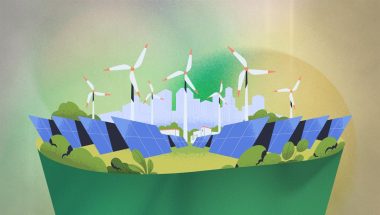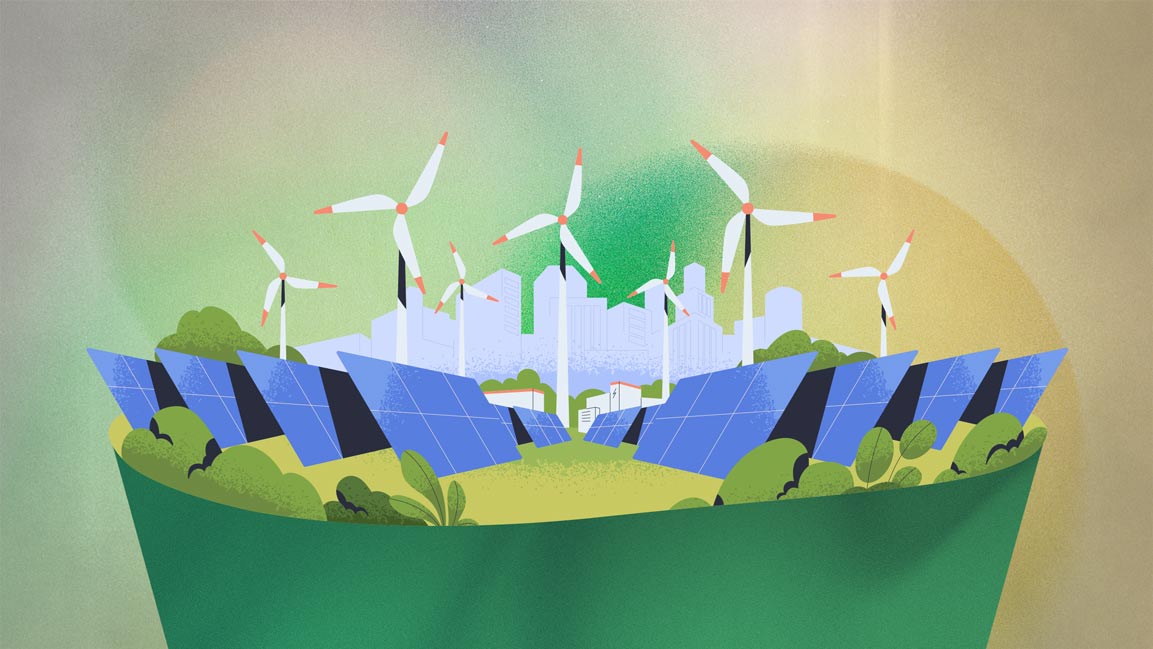- | 9:00 am
Egypt is ramping up initiatives to transition to low-carbon energy. Will it succeed?
Experts say developing renewable energy is essential to tackle inconsistent gas production, secure adequate power production, and reduce CO2 emissions.

Egypt’s population, which now stands at 104 million, has more than doubled over the past four decades. And just last month, Egyptian President Abdel Fattah al-Sisi said the country’s water resources could no longer meet the needs of the growing population. The rapidly increasing number of people has also increased energy demand, straining the country’s energy resources.
To ensure energy supply, the government is pursuing an energy diversification strategy known as the Integrated Sustainable Energy Strategy 2035. This involves the development of renewable energy and energy efficiency. To date, the total installed capacity of renewables amounts to 3.7 GW, which includes 2.8% GW of hydropower and about 0.9% GW of solar and wind power.
The set target by the government is 20% of the electricity mix by 2022 and 42% by 2035.
DIVERSION TOWARDS RENEWABLES
Egypt has come a long way in energy production. The country faced severe power cuts and energy crises a decade ago, which bottomed out to the lowest in 2014.
Consumption outstripped production, which led Egypt to incur millions of dollars in debt exporting gas. Now, capable of producing its natural gas, Egypt has paid off its foreign oil debts, and there’s a diversion towards renewables.
“Egypt has no choice but to transition to net zero emission. The country must use natural resources such as solar and wind; take grants and soft loans for green finance projects, adopt green energy, and turn its head away from blue hydrogen,” says Osama Fawzy Georgy, a sustainable energy expert and Executive Director of EgyActive.
Egypt has signed multiple agreements on blue hydrogen production in the country. But experts say blue hydrogen from natural gas is still a high burden due to the cost of carbon capture, utilization, and storage, which most oil & gas companies are reluctant to invest in.
SUPPLY CHAIN CHALLENGES
Meanwhile, the pandemic and the Russia-Ukraine conflict have disrupted supply chains. Egypt’s power generation capacity is around 27 GW per year, and approximately 60-70% of it operates due to its inability to import raw materials necessary to produce power.
According to Khaled Diab, Director of Communications at Carbon Market Watch, the supply of certain critical raw materials presents a challenge as the transition to renewable energy picks up. “This underscores the vital importance of a truly circular economy that safeguards the sustainable use of resources.”
“With renewables, we should avoid errors we made with fossil fuels. As much as possible, we should construct a decentralized, distributed energy grid of prosumers,” adds Diab.
Volume shortage, long lead times, quality, and price volatility depends on the supply chain. Selectively switching to renewable throughout the supply chain can decrease long-term costs, provide price stability, alleviate future regulatory risk, intensify brand worth, and drive new revenue, say experts.
THE STUMBLING BLOCK
Between 2013 and 2018, the analysis of energy financing from the world’s largest governments and multilateral developments shows that fossil fuels received three times more public funding than renewable energy, with natural gas being the largest beneficiary.
In sub-Saharan Africa’s low- and lower-middle-income countries, oil and gas are the fastest-growing power generation sources. Since 2010, oil and gas generation has increased 12 times compared to solar and wind.
“The energy crunch we are currently facing is partly due to our addiction to fossil fuels and partly due to the lethargy with which the world has approached the transition to renewable energy,” says Diab.
Egypt’s primary energy consumption in 2019 for natural gas accounted for 53%, and petroleum and other liquids came next with roughly 40%. In electricity production, natural gas and dual-fuel plants account for 90% of the power produced.
Developing renewable energy in Egypt now represents a significant element in addressing these challenges to secure adequate power production due to inconsistent gas production levels and tackling CO2 emissions.
Egypt’s portfolio for eligible green projects is worth $1.9 billion, with 16% in renewable energy, 19% in clean transportation, 26% in sustainable water and wastewater management, and 39% in pollution reduction and control.
“The production process of oil & gas either offshore or onshore emits CO2 emissions. It is a transitional period with an energy mix of gray and black energy, representing 80%, and a balance of 20% for green energy from solar, wind, and green hydrogen. It will gradually change from decreasing the 80% of fossil fuels to 50% and increasing green energy from 20% to 50% by 2030 for Egypt,” says Georgy.
TRANSFORMING ENERGY MARKET
With more than 100 million people, the country’s energy situation is changing fast. Sustainable sources like wind and solar are the future.
To combat climate change, Samir Tantawi, Senior Climate Change Consultant/UNDP Project Manager, says, “Egypt has to develop climate change strategy, work on adaptation strategy, develop a list of projects and measures to counter these climate changes.”
The ravages of extreme weather have become a feature of daily life. “Egypt has faced challenges due to climate changes like rising sea levels, heat waves, droughts, and sudden heavy precipitation,” says Tantawi.
Last week, al-Sisi discussed the results of the Sharm El-Sheikh climate summit COP27 and directed to integrate development efforts and the climate action agenda by mobilizing diversified funding for green development projects within one national program.
Over $10.3 billion in financing packages for government sectors were offered by multiple development partners to implement diverse national projects, including energy. The Nexus on Water, Food and Energy program aims to implement wind power plants, clean energy, and green hydrogen and reduce dependence on traditional fuel.
“Priority needs to be given to vulnerable sectors, coastal areas, agriculture, and water resources in national planning with support to the potential transition to renewable energy and clean fuel,” says Tantawi.
Agreeing with him, Diab adds, “If we wish to safeguard our energy security and prevent the disruptive and destructive effects of climate change, we must accelerate our exit from coal and fossil fuels.”







































